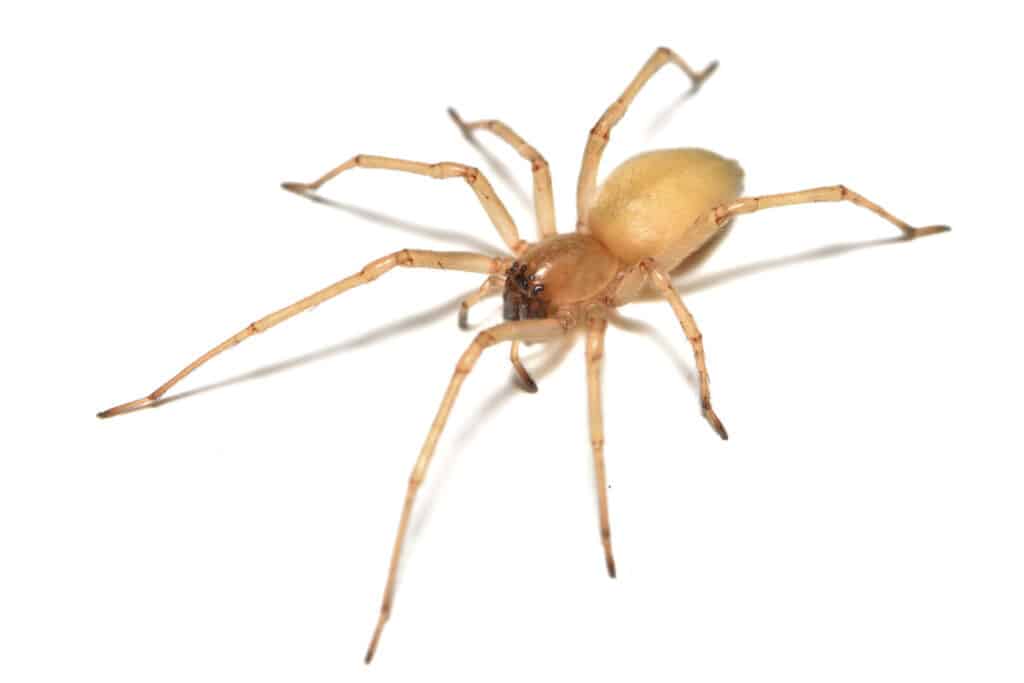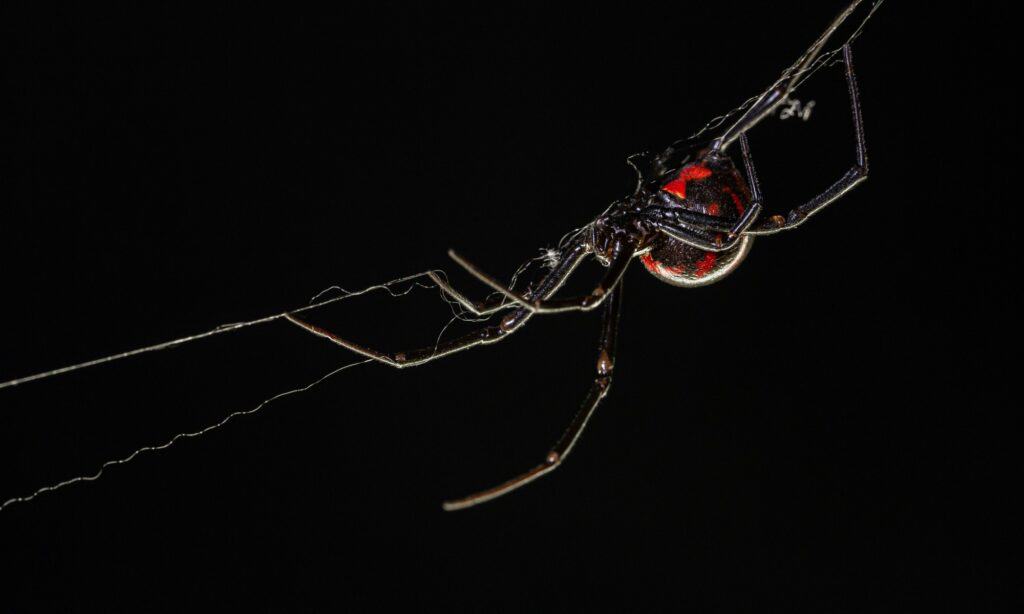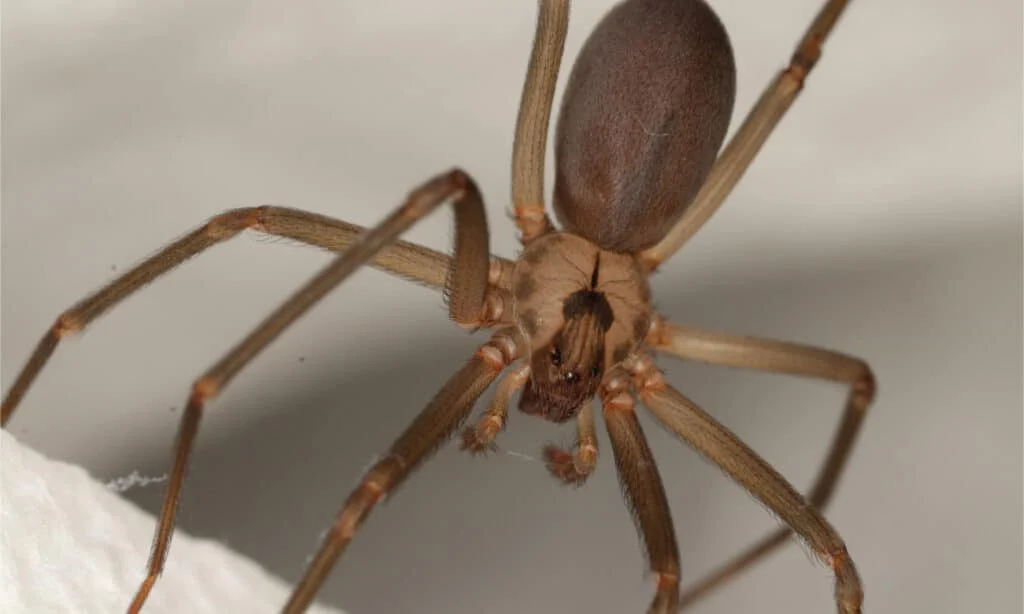Spiders are one of the world’s most feared animals, but not all of them are dangerous. While nearly all spiders are able to produce venom, only a select few species are actually dangerous to humans. Across the US a few dangerous spiders can be found, but this article will cover 4 of Mississippi’s most dangerous spiders.
A spider’s venom is primarily used to neutralize the prey that it hunts. Spiders have neurotoxic, or necrotic venom, and use their fangs to inject their prey. It is rare for a spider to bite unless threatened, but bites can happen if you disturb one hiding in an unsuspecting area. Let’s take a look at Mississippi’s 4 most dangerous spiders, and how you can spot them.
1. Northern Yellow Sac Spider (Cheiracanthium mildei)

The northern yellow sac spider builds a silk sac to hide from predators
©Tobias Hauke/Shutterstock.com
The northern yellow sac spiders are dangerous spiders in Mississippi but are originally native to Europe, Africa, and parts of Asia. This species is now abundant in the northeastern United States, active most from spring to fall. Northern yellow sac spiders have yellow to cream coloring, and adults range between 4 to 10 mm (0.15 to 0.39 inches). This spider has eight eyes arranged on the front of its face, arranged in pairs of twos. At night when shined with a light, their eyes glow due to the tapetum lucidum tissue behind the eyes, giving them superb night vision.
The venom of this spider is cytotoxic, damaging the cell tissues in the area a bit. Lesions in the area may occur, as well as other symptoms including fever, nausea, and headache. This spider’s bite is more potent than most other species in Mississippi, and medical treatment may be required.
Where To Spot Yellow Sac Spiders
Northern yellow sac spiders live all across Mississippis, and the United States. This spider is nocturnal, and during the day they will hide in silk sacs they create. Northern yellow sac spiders bite more humans than most spiders since they have a tendency to make their way into homes. During the night this spider wanders for food and can be found on walls, ceilings, and walking around foliage. While this spider is regularly found in homes, they also live in woodlands and other vegetated habitats.
2. Brown Widow (Latrodectus geometricus)

The ventral side of the Brown Widow spider, showing the hourglass pattern on the abdomen
©Decha Thapanya/Shutterstock.com
Brown widows are one of three Latrodectus species that inhabit Mississippi and are closely related to the infamous black widow. Adult females have a body size of around 8 to 12 mm (0.3 to 0.5 inches). They have a tan mottled pattern on their rounded abdomen, with long brown legs with dark bands on them. Like the black widow, this species has an hourglass shape marking on the bottom of its abdomen, but it is orange instead of red. Male brown widows are much smaller than females and do not bite.
It is rare for the brown widow to bite, and is much less aggressive than the black widow. If it does bite this spider administers much less venom, and symptoms from the bite are mild. The reaction to the bite is localized to the area that is bitten, and symptoms like swelling, redness, and pain may occur.
Where To Spot Brown Widows
The warm months of summer and fall are when the brown widow is most active. This spider creates messy webs to live in, as it is a part of the Theridiidae tangle web spider family. Brown widows create their web in dark and secluded areas. Dense woody vegetation, empty flower pots, outdoor furniture, and wood piles are common places this spider hangs around. It is active at night, and during the day will rest in a secluded area.
3. Black Widow (Latrodectus mactans/Latrodectus variolus)

The web of a black widow is 5 times stronger than steel.
©iStock.com/AmericanWildlife
Mississippi houses two species of black widow, both with a very potent bite. The northern black widow (Latrodectus variolus) and the southern black widow(Latrodectus mactans) are the two black widow species you can find in the state. The bite from this spider injects venom that is around 15 times stronger than a rattlesnake, but only a small amount is injected making it less potent. Males do not bite, as they are too small to puncture the skin. These spiders are some of the most dangerous spiders in Mississippi, but deaths are rare.
The female black widow is known for the red hourglass marking that appears on the bottom of her abdomen. The northern black widow’s hourglass is incomplete and slightly smaller than the southern black widows. Both species are jet black, with a large bulbous abdomen and spindly legs. Red, white, or orange markings may appear on the back of the black widow, but as they age and molt they turn completely black.
Bites from a black widow may cause latrodectism, which is the sickness caused by the venom of this species. Symptoms like nausea and muscle spasms may occur, but with medical treatment, you can be given an anti-venom.
Where To Spot The Southern Black Widow
Black widows are most active in the summer and fall months. They create messy webs to live in, in dark secluded areas. Under outside furniture, bushes, woodpiles, empty pots, and other crevices are where they are regularly found. This species is active at night, and during the day will hide in a secluded area. Black widows do not have very good eyesight and use vibrations from their web to sense the world.
4. Brown Recluse (Laxosceles reclusa) 
The brown recluse is one of the most dangerous spiders in Mississippi, and also inhabits at least 16 other states within the US (its range continues expanding).
Other states the brown recluse lives in include:
- Texas
- Tennessee
- Ohio
- Oklahoma
- Georgia
- Nebraska
- Mississippi
- Michigan
- Louisiana
- Kentucky
- Kansas
- Iowa
- Indiana
- Illinois
- Alabama
- Arkansas
Brown recluses have all brown coloring, and other brown spiders are often confused for this fearsome species. The dark violin mark that appears on its cephalothorax is its most identifiable trait. This species is completely brown, lacking any other brown markings on its body like bands or blotches. Brown recluses tend to range around 6 to 20 mm (0.24 to 0.79 inches), with females being larger.
The brown recluse is one of the most dangerous spiders in Mississippi due to its venom which is cytotoxic and hemolytic. The venom destroys the skin, cells, nerves, and blood vessels in the area a bit, and medical treatment is usually needed. Even for this species death from bites are rare, and symptoms vary for each bite. Brown recluses will only bite when provoked, and since their fangs are small the initial bite is not usually painful.
Where To Spot The Brown Recluse
Brown recluses prefer to live in dark, dry areas and are often found under natural debris in the wild. Rocks, logs, and other secluded areas are where they live. Woodlands and other forested habitats are areas where brown recluses live more often. They are active at night, spending this time hunting for small insects to feed on. This species may occasionally make its way into homes, hiding under places like laundry or cardboard.
The photo featured at the top of this post is © Cornel Constantin/Shutterstock.com
Thank you for reading! Have some feedback for us? Contact the AZ Animals editorial team.






